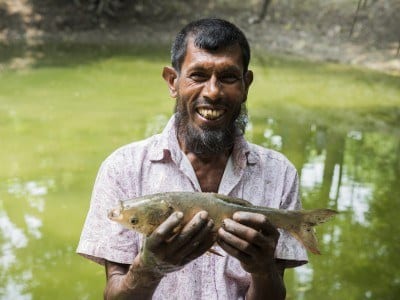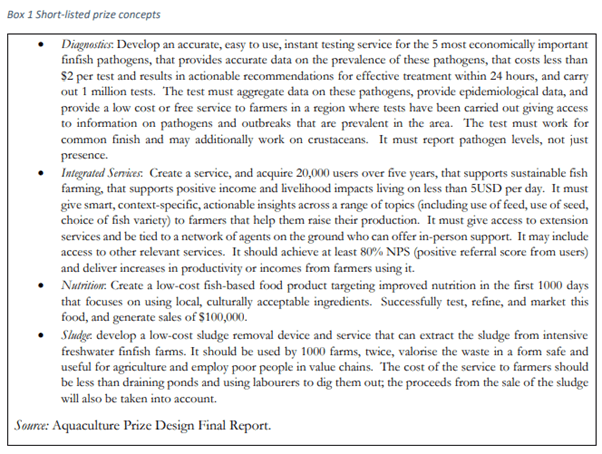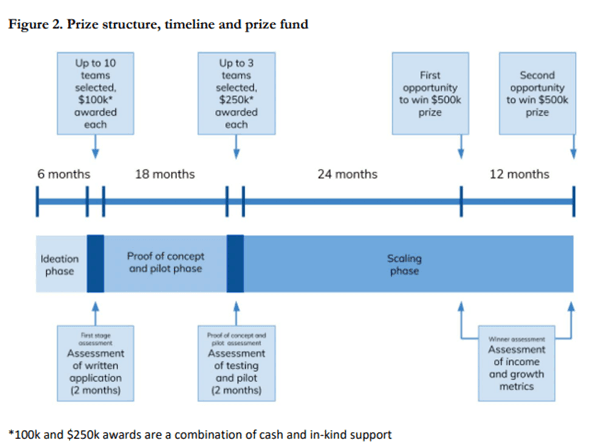Nesta

Location
Bangladesh, India
Sector
Livelihoods
Type of Investment
Grant
Project Stage
Test & Transition
Length of Investment
2016-2017
Investment Overview
Nesta carried out research on market failures in aquaculture in Bangladesh and India, and designed an incentive prize to accelerate innovation in aquaculture with a view to improving social and economic outcomes for the poor.
The Development Challenge
Malnutrition is a global challenge. At the time of GIF’s grant, 795 million children and adults were undernourished globally, and the highest number of undernourished people – 281 million (15.7% of total) – lived in South Asia. Approximately 194.6 million people were undernourished in India. This represented the greatest number of people suffering from hunger in any single country. The prevalence of undernourishment was at 15% of the population in India, and 16% of the population in Bangladesh. Rates of malnourishment in both countries remain high. Most importantly, malnutrition has long-term negative health and developmental effects, particularly on pregnant women and children. Investing in improved nutrition can be highly cost-effective – the estimated benefits for every dollar spent on child nutrition can lead to a savings of up to $134 in India, and $62 in Bangladesh.
The Innovation
Nesta, in collaboration with the University of Sterling and Forum for the Future, planned to design a ‘Challenge Prize’ in Aquaculture for Global Development to address market failures and accelerate innovation in aquaculture in India and Bangladesh. This built on extensive economics literature at the time which indicated that prizes could be an effective tool for spurring innovation and investment, particularly in instances where market failures made private returns to investment smaller than social returns. At the same time, aquaculture had grown rapidly in the past decades and could play a major role in satisfying the nutritional needs of the growing middle-income group, while also meeting the food security needs of the poorest.
Our Investment
GIF’s grant of USD239K supported Nesta with the design phase for a Challenge Prize in Aquaculture for Global Development to result in a launch-ready incentive prize. Work included research on market failures, stakeholder mapping and analysis, prize prototyping, and final prize design.
Progress to date
Following a design phase to scope and identify multiple prize amenable problems, Nesta developed prize prototypes for a shortlist of concepts. The prize design resulted in a proposed Integrated Services Prize aimed at improving the productivity of small farms with the goal of benefiting fish farmers, through improved output and profitability, as well as consumers, through an increased supply of fish at lower cost. Unfortunately, the prize did not receive the funding required to be implemented. However, the design process produced valuable learnings on the challenges and potential trade-offs between “prizability”, i.e. how easy it is to specify what success looks like, and developmental impact. These learnings include the centrality of using a theory-of-change approach in the design and evaluation of prizes as well as with other funding instruments.
Nesta in numbers
Malnourished children globally are in India
GIF grant
Nesta Completion Report
GIF provided Nesta, the UK’s independent social innovation agency, with a GBP 239,230 grant to design a Challenge Prize in Aquaculture for Global Development. The prize design resulted in a proposed Integrated Services Prize aimed at improving the productivity of small farms with the goal of benefiting fish farmers, through improved output and profitability, as well as consumers, through an increased supply of fish at lower cost. At the time of this investment assessment, neither GIF nor other funders have dedicated resources for the prize’s implementation and thus the original vision of success was not achieved. However the Integrated Services Prize may be considered for funding in the future and the design process produced valuable learnings on the challenges and potential trade-offs between “prizability” and developmental impact. These learnings include the centrality of using a theory-of-change approach in the design and evaluation or prizes as well as with other funding instruments.
Innovation
GIF funded Nesta, in collaboration with University of Stirling and Forum for the Future, to design a launch- ready Challenge Prize in Aquaculture for Global Development. The challenge prize was envisaged to address market failures in aquaculture and spur innovations to improve nutrition of, and economic benefits to, GIF’s Target Beneficiaries in India and Bangladesh. The innovation funded by GIF was Nesta’s bespoke approach to prize design, following a comprehensive process for making strategic choices on the core design elements, based on criteria on prizability and potential impact.
Goal of investment
The grant’s main objective was to design a launch-ready Challenge Prize in Aquaculture for Global Development, which would address aquaculture’s market failures in India and Bangladesh. Although the grant agreement did not define specific objectives, the milestones for disbursement included the requirement for a final report to include:
- analysis of current market failures in this field;
- analysis of socio-economic benefits that a Prize could bring to those living on less than $5 per day
- and any social outcome data gathered;
- Prize Rules and Conditions, including governance and assessment arrangements
- Prize budget
- Launch-ready prize delivery plan, including a communication plan.
Type of investment
GIF provided Nesta a GBP 239,230 grant.
Implementation
The design phase of the Challenge Prize in Aquaculture for Global Development was implemented between November 2016 and September 2017.
The process included 2 phases:
- Phase 1: Scoping and identifying multiple prize-amenable problems;
- Phase 2: Prototyping, design, and testing.
It was overseen by a nine-person Steering Committee consisting of external experts in addition to representatives of Nesta and GIF.
Phase 1 included a literature review on “Evaluating opportunities for innovation across aquaculture product value chains for poverty reduction in Bangladesh and India,” conducted by the University of Stirling. Nesta also undertook interviews with aquaculture experts and site visits to fish farms, markets, and other stakeholders in Bangladesh and India.

In Phase 2, prize prototypes were developed for the four short-listed concepts. After reviewing these, the Integrated Service and Nutrition concepts were selected for further development in large part because the link with well-being of poor people was clearer and more direct. Detailed designs were created for both of these concepts. Ultimately the Integrated Service concept was chosen as the priority prize for potential follow-up.
One of the challenges faced by the project team was lack of experience in economic impact analysis. This necessitated GIF consultation and support to ensure prize design alignment with GIF’s criterion of impact on beneficiaries.
Results
Nesta and its partners produced a relatively detailed plan for the Integrated Services Prize, including prize rules and governance, eligibility and judgement criteria, an indicative budget, proposed implementation approach and key activities, and a communication strategy. The criteria for awarding the final prize included the degree to which the service improved household income from fish, to be assessed via a quasi- experimental evaluation. The monitoring and evaluation plan also envisioned a quasi-experimental or experimental measurement of income or productivity gains (possibly incorporating the one used for prize judgment).
Following the design phase, GIF continued partial engagement and supported Nesta to fundraise for the prize and prize implementation. At the same time, GIF was able to keep open its options to fund the evaluation of impacts on household income, or to fund selected innovators, as well as participate in the prize judgment panel and provide advice on evidence. GIF had conversations with potential funders in mid-2018, but gradually other activities took precedence. Nesta last submitted a formal funding proposal in July 2019, and last included it in a list of proposed prizes to a potential funder in November 2021.
The Integrated Services Prize sought to improve the productivity of small farms and benefit individual fish farmers through improved output and profitability as well as consumers through increased supply of fish at lower cost. The prize’s challenge statement is as follows:
- The integrated services prize will reward a competitor that can create a service that helps smallholder fish farmers in India or Bangladesh substantially increase their production and profit.
- The prize will be awarded to the best service that increases household incomes by improving practices in fish farming. This will be achieved through offering smart, context-specific, actionable insights across a range of topics (including - but not limited to - use of inputs, choice of fish variety, management of fish health). The service may also include access to other relevant services such as access to finance, sale of inputs or market information.
- After five years, competitors should have acquired 50,000 regular or repeat users in India and/or Bangladesh, and demonstrate positive income and livelihood impacts for people living on less than 5 USD (PPP) per day.
- The service must be linked to agents or representatives on the ground who can provide in-person support.
The total prize pot was envisaged at $2.25 million and included financial awards and capacity development support, with the winner’s grand prize set at $500,000 and a tiered structure of interim prizes was envisaged to support teams along the scaling path. This complex tiered prize plan, however, was viewed as not easily compatible with GIF’s criteria for Test & Transition or Scale investment phases, and the lack of clarity may have negatively affected Nesta’s prize design choices.

- Launch: The prize is formally launched; promotion begins.
- Ideation phase: Open application window: six months in which the prize is heavily promoted
- and innovators develop their ideas.
- Proof of concept and pilot phase: Up to 10 teams selected for this phase from those who entered the first stage assessment. In this 18 month phase, teams awarded $100,000 each (a combination of cash and in-kind support paid in tranches subject to adequate monitoring) to support the testing, developing and piloting of their product.
- Scaling phase: Up to three teams selected for this phase from those participating in the Proof of concept and pilot phase. In this 24-36 month scaling stage, teams are awarded $250,000 each to support the development of their business plan and acquisition of new customers.
- Winner: One winner chosen from the teams participating in the Scaling stage for $500,000 grand prize.
The judging criteria for selecting shortlisted teams and the grand winner at each stage of the process would be focused around: innovation; user insight; range of services; quality of services; impact; data; market sustainability; and ecological sustainability. Although most of the indicators are qualitative, the winner would have to demonstrate reaching at least 50,000 beneficiaries and increasing incomes for people living under $5 a day. As noted, the team proposed to carry out a quasi-experimental evaluation of the impact on farmers’ incomes, to be designed by an assessment partner.
An important result of the investment is that working with GIF contributed to the evolution of Nesta’s approaches on scale, as detailed further under learnings
Learnings at the level of the innovation
- The process of designing prizes presents challenges and potential trade-offs between prizability and development impact.
Of the four short-listed concepts, the more technical innovations (disease detection and sludge removal) were more prizable – it was easier to specify what ‘success’ looks like – but the connections to improving the livelihoods of poor people were less well defined. On the other hand, Integrated Services innovation would help poor people, by definition (impact on GIF’s target beneficiaries was formulated as a criterion in itself), but the expected activities and outputs were less clear (for example, choosing an app-based model or extension services). This made it more difficult to evaluate and determine the basis for awarding the prize. This challenge is consistent with the conclusion of a recent review of 13 prizes awarded under the DFID-funded Ideas to Impact (I2I) programme - Prize designs aimed at improving social outcomes should include a detailed theory of change and appropriate evaluation approaches. Throughout the aquaculture prize design process, a significant challenge was determining how outcomes and impact would be achieved and effectively demonstrated.
- The prize modality fosters additional scrutiny of assumptions on pace of implementation and number of people reached.
The target of reaching 50,000 people (with the Integrated Services prize) was viewed as an ambitious target by aquaculture and South Asia experts, but as a low target for a GIF test and transition investment. - Prizes can have similar challenges to social impact bonds. Both prizes and social impact bonds condition payments on achieving targets against specified indicators. It can be challenging to design (and agree on) indicators that can be readily measured, that capture the goal of the prize or bond, and that don’t introduce perverse incentives. For the Integrated Services prize, it remains an open question whether the impact on fish farming-income (a prize criterion) can be cost-effectively measured via experimental or quasi-experimental means.
Learnings for key stakeholders, funders, replicators, scalers-up
- More research is required to understand what prize structures work for particular challenges or objectives. The work on the aquaculture prize design raised important questions on what type of prizes structures work in particular contexts. For example, for reaching certain development outcomes, would it work better to have many winners with little support, or one winner with a big pay-out? What type of prize structures would accelerate models, and what would generate more diverse innovations? Nesta is now starting to probe more on impact and develop approaches on experimental design to prize structures to address some of these questions.
- Prize designs are more likely to be funded and implemented if they are supported by specialised funders. Specifically, supporters who own the specific problem and see the potential of the prize as a solution to that problem. For example, the Nesta’s most recent successful examples of prize design (one addressing dementia and another on arthritis and pain) were supported by organisations working on these specific issues, who then took the lead on fundraising. The credibility of the funders in the sector and their seed funding helps crowd in other funding for the prize.
- Prizes can be used to incentivise scale. Historically, Nesta’s work has been focused on innovation and prototype. Working with GIF provided some space for the Challenge Prize Centre to think about scale and what growth targets would look like. This proved useful in crafting a prize on scaling solar-reflective cool roofs to relieve heat stress in developing countries. The target is to deploy a million square meters of cool roofs.
Learnings for GIF
- Learning objectives should be formulated more explicitly during the contracting phase. Although the deal team explicitly indicated in its due diligence that one of the reasons for funding the prize design was to learn about prizes as outcome-based payment instruments, it was not intentional in how these learnings will be produced. Consequently, the prize design resulted in some important lessons, but they were not thoroughly systematised or publicised.
- It is important to consider a deal’s scaling strategy early on and be engaged consistently in portfolio management to facilitate scale. GIF was unwilling to commit in advance to funding implementation of a yet-to-be-designed prize. It could have been useful to include some potential funders in the Steering Committee early on.